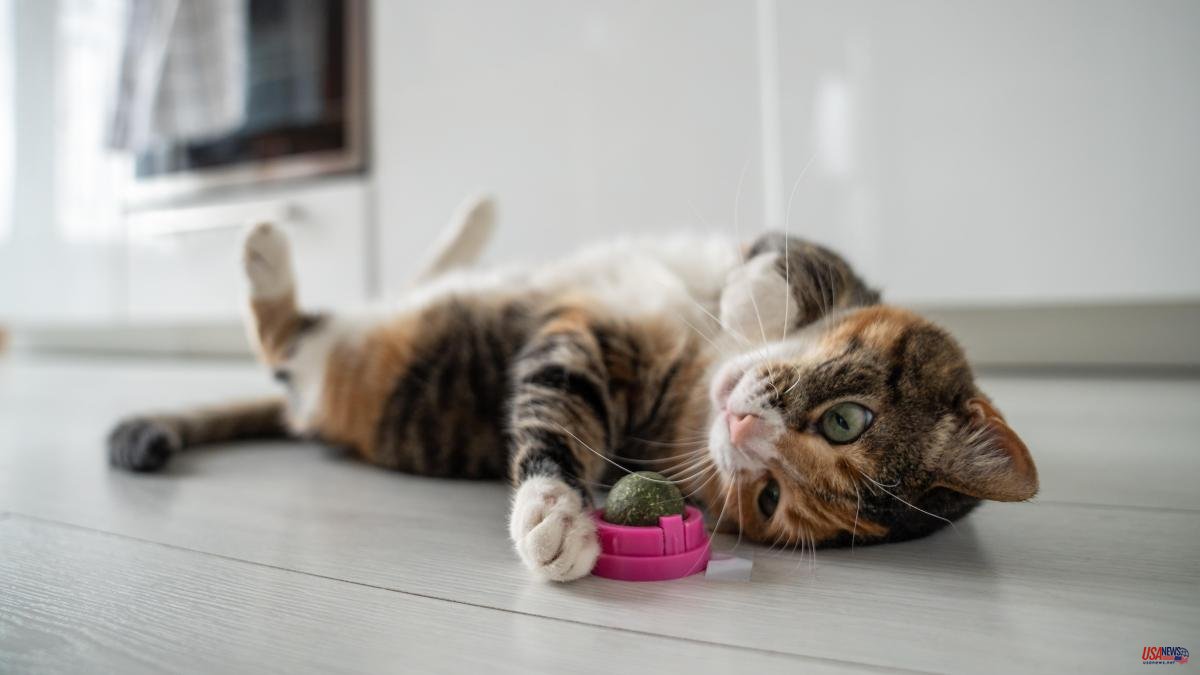Your cat approaches a plant that looks similar to peppermint or mint, sniffs it for a few moments, and then suddenly transforms. He is the happiest cat in the universe, or so it seems. He rubs against the plant, rolls around, can grab the plant with his front paws and hit it with his hind legs, hunts imaginary mice, and when the effect wears off, he relaxes. What is happening to him? The explanation is none other than the plant itself, catnip, also known as cat grass, cat basil, catnip or catnip.
Its botanical name is Nepeta cataria, a plant from the mint family whose leaves have a mild citrus aroma. Like wild mint, this herbaceous plant grows wild in vacant lots, hedgerows, or embankments.
Catnip releases nepetalactone, a volatile oil, into the air with stimulating effects in two out of three cats. When detected at the olfactory level, nepetalactone activates what is known as the "catnip response" (catnip response). A transitory euphoric effect, which does not last more than 5-10 minutes, in which the cat has some reactions that can be very peculiar to us: it begins to rub against the plant or the object that contains its scent, it rubs against the ground, it rolls around, it can grab the plant with its front legs and hit it with its hind legs, sometimes it seems that it is hunting imaginary mice... After the effects have passed, it relaxes and, often, begins a cleaning session. And in the next 30 minutes, it will be 'immune' to the effect of catnip for about 30 minutes.
Catnip typically has these euphoric effects in two out of three cats. However, according to a recent study, the remaining one also reacts, but it does so in a more discreet way: getting into a sphinx position, meowing less, and relaxing. In the 1960s, geneticist Neil B. Todd, with several scientific publications on cats, attributed the euphoric reaction to catnip to a genetic origin. Years later, the researchers Hart and Leedy delved into the study of the effects of catnip, reaching the conclusion that they also depend on age, since cats under three months never show this arousal reaction.
What does not seem to affect, in terms of sensitivity to catnip, is the sex of the cat. Sterilization does not change these behavior patterns either. It is something important to take into account, especially the pet parents of felines, since when they roll on the ground under the effect of catnip, their behavior is reminiscent of a cat in heat, but, in reality, it has nothing to do with it. see.
Although the reaction to catnip is harmless to cats, certain precautions should be taken, such as making sure that the space in which our cat is located is free of danger. We must also be careful in cases where the cat becomes more irritable after use, especially in those houses where there are babies, small children or other cats.
Out of curiosity, you may be surprised to discover that these effects are not exclusive to cats. Other cats, such as jaguars, lynxes or leopards, also experience them, while dogs, on the other hand, remain completely indifferent.
You should know that contact with this herb favors the release of endorphins. Therefore, not only does the cat appear happy, but scientific studies show that catnip provides a state of true pleasure, without the risk of the cat developing a catnip addiction.
On the other hand, by rubbing against catnip leaves, cats involuntarily impregnate themselves with nepetalactone. This substance can be beneficial by acting as a repellent against some mosquitoes, so that cats are protected against bites.
Finally, this stimulant awakens their desire to play with that toy that smells like catnip, which favors greater activity in those house cats with more sedentary lives; and it can also stimulate scratching in suitable places, if applied, for example, on their scratching posts.
The most natural and long-lasting option is to have a Nepeta cataria at home, since you only have to water it and take care of it as we would with any other plant. In this case, we only have to buy the seeds in a specialized store or, directly, purchase the plant in a nursery.
Eye! When ordering it, it is advisable to do so with the botanical name of the plant (in all nurseries they are accustomed to using them), since in this way we will avoid the usual confusion with grass shoots, which are also marketed under the name of "cat grass" to stimulate intestinal transit. At first glance the differences are clear, since the latter have the appearance of threads of grass. However, it is better not to take risks and ask for catnip by its official name.
For reasons of space, decoration or practicality, other cat parents opt for dried or spray catnip, ready to spray on their favorite toys to encourage play or on the scratching post to encourage proper use.
You can also find toys and other items for cats with catnip extract inside. In these cases, it should be taken into account that, as it is a volatile oil, objects impregnated with nepetalactone gradually lose effectiveness. A tip to prolong their effects as long as possible is to store them in airtight bags in a cool, dry place and away from direct sunlight. Detecting when to impregnate their toys again is easy: when we appreciate that the cat stops responding to that stimulus, it is time to reapply the product.
Now you know: if you dare to try catnip with your cat, follow these recommendations for proper use. Remember that not all cats react to this plant in the same way, so you will have to be patient if you need to do several tests with different sources of catnip until you find the most effective one.
*Source used to make this article:
Is catnip good for my cat?













